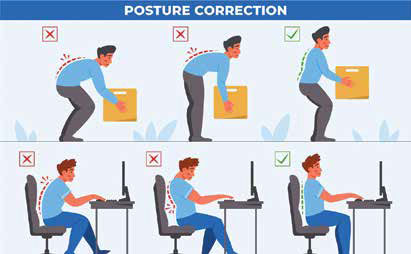Getting over the stress and fatigue, fighting the after effects of Covid 19, we bring what has been discovered to cause ill effects on the human system. Read on, to find some quick fix solutions.
Most people who got coronavirus disease COVID-19 recovered within a few weeks. But some people, even those who had mild versions of the disease, might have symptoms that last a long time afterward.
This Post COVID-19 syndrome involves a variety of new, returning or ongoing symptoms that people experienced more than four weeks after getting COVID-19. In some people, post-COVID-19 syndrome lasts for months or years or caused disability.
Research suggests that between one month and one year after having COVID-19, 1 in 5 people age 18 to 64 had at least one medical condition that might be due to COVID-19. Among people age 65 and older, 1 in 4 had at least one medical condition that might be due to COVID-19.
Some individuals may experience lingering symptoms or complications even after recovering from the acute phase of the illness. The most commonly faced issue is fatigue and weakness. Some people reported persistent fatigue and weakness, which impacted their daily activities and lasted for weeks or months. Both children and senior citizens have gone through different intensities and frequencies of weakness.
The second common problem that arose after COVID was respiratory issues. COVID-19 led to respiratory problems such as shortness of breath, coughing, or reduced lung function, which has persisted after the initial infection. Cough and breathlessness has lasted more than 6 months in few cases.
Another issue post-COVID people faced was cognitive difficulties: Some individuals experienced brain fog, difficulty in concentrating, memory issues, or other cognitive challenges after COVID-19.
Due to infection and prolonged inflammation, COVID affected the joints and muscles. Long-lasting symptoms like muscle aches, joint pain, headaches, loss of taste or smell, sleep disturbances, and mood changes were reported by some people.
How COVID led to adverse postures, habits and patterns
During the COVID-19 pandemic, many people spent increased amounts of time in sitting due to factors such as remote work, online classes, and limited physical activities outside the home. This prolonged sitting contributed to the development of poor posture.
The most obvious and immediate challenge everyone faced were:
- Ergonomic challenges: Working or studying from home may not provide access to proper ergonomic setups like adjustable chairs, desks, or computer monitors. Without these, individuals had to adopt uncomfortable positions that strained their posture.
- Lack of movement: When sitting for long periods without breaks or physical activity, muscles become weak and tight. The lack of movement reduces the opportunities to stretch and strengthen muscles necessary for maintaining good posture. Consequently, this has lead to pains and aches in joints and muscles.
- Increased screen time especially for children: Spending more time on digital devices during remote work or leisure activities can lead to “tech neck” or forward head posture. Continuously looking down at screens can strain the neck and upper back muscles.
- Stress and anxiety: The pandemic brought about increased stress levels for many individuals. Stress can lead to muscle tension, which may contribute to poor posture, sleep issues, digestive issues and increased discomfort.
Ways Your Posture Affects Your Health
Bad posture always feels comfortable yet can have a negative impact on organ functioning because it can compress and restrict the movement of organs, impede blood flow, and disrupt the natural alignment of the spine.
Here are a few ways in which bad posture can be detrimental to organ functioning:
- Reduced lung capacity: Slouching or hunching forward can compress the chest and restrict expansion of the lungs. This can lead to shallow breathing and reduced oxygen intake, which can impact overall organ function and energy levels. Sitting right instantly increases the energy levels and improves focus. Bad posture, particularly in the neck and upper back, can strain the muscles and put pressure on the nerves in those areas. This muscle tension and nerve compression can lead to tension headaches, which may trigger migraines in susceptible individuals. Additionally, poor posture can affect blood flow to the brain and increase tension in the neck and shoulder muscles, both of which are associated with migraines.
- Digestive issues: Poor posture, especially when sitting or slouching after meals, can compress the abdomen and disrupt the normal functioning of the digestive system. This compression can impede digestion, slow down the movement of food through the intestines, and contribute to problems like acid reflux, bloating, and constipation. Reflux or heart burn is a lifestyle disorder and has become almost like epidemic, even teenagers feel it. Endoscopy does not show anything internally when examined, leading to overdose of antacid medications.
- Circulatory problems: Bad posture can interfere with proper blood circulation. For example, sitting with crossed legs or slouching can compress blood vessels and impede the flow of blood to vital organs. Restricted blood flow can lead to decreased oxygen and nutrient delivery, affecting the overall health and function of organs. It may also lead to cases of varicose veins, restless leg syndrome and swollen ankles.
- Spinal misalignment: Bad posture often involves an unnatural alignment of the spine, which can lead to issues with the nervous system. The spine houses the spinal cord, which connects the brain to the rest of the body. When the spine is misaligned due to poor posture, it can put pressure on the nerves, interfering with the proper functioning of the nervous system and potentially affecting organ function.
- Muscle imbalances: Maintaining poor posture over time can lead to muscle imbalances, with certain muscles becoming tight and others becoming weak. These imbalances can affect the support and stability of the organs, potentially leading to issues such as pelvic floor dysfunction or urinary problems, weakness and stiffness in the body.
The Solution Going Forward
Having good posture is about more than looking good. It helps you to develop strength, flexibility, and balance in your body. These can all lead to less muscle pain and more energy throughout the day. Proper posture also reduces stress on your muscles and ligaments, which can reduce your risk of injury.
Improving your posture also helps you become more aware of your muscles, making it easier to correct your own posture. As you work on your posture and become more aware of your body, you might even notice some imbalances or areas of tightness you weren’t previously aware of.

How one can improve posture in general
- Be mindful of your posture during everyday activities, like watching television, washing dishes, or walking.
- Stay active. Any kind of exercise may help improve your posture, but certain types of exercises can be especially helpful. They include yoga, tai chi, and other exercises that focuses on body awareness. It is also a good idea to do exercises that strengthen your core (muscles around your back, abdomen, and pelvis).
- Maintain a healthy weight. Extra weight can weaken your abdominal muscles, cause problems for your pelvis and spine, and contribute to low back pain. These can hurt your posture.
- Wear comfortable, low-heeled shoes. High heels, for example, can throw off your balance and force you to walk differently. This puts more stress on your muscles and harms your posture.
- Make sure work surfaces are at a comfortable height for you, whether you are sitting in front of a computer, cooking food, or eating a meal.
- If you have concerns about your posture or organ health, consulting with a healthcare professional or physical therapist would be beneficial.
Dr Isha Sehdev runs a fully equipped clinic EEZ ALIGN on a Golf Course Road in Gurgaon and has experience of 15 years in Physical Therapy. She has a team of manual physiotherapists who believe in detailed assessment and examination and craft a unique treatment plan according to the client.
Some of the key issues that she has facilitated people to resolve are Migraines/headaches, back discomfort, poor circulation, poor posture, sciatica, jaw pains, chronic ankle sprains, frozen shoulder, fatigue, herniated discs, Muscle strains, running injuries, scoliosis, Menstrual issues, urinary incontinence, carpal tunnel syndrome, tennis and golfer’s elbow, foot and ankle injuries.
With a strong commitment to patient care, she was always keen in learning the most advanced techniques and concepts. Besides being a physiotherapist specialised in orthopaedic she is an Osteopath from Ontario University, Canada, a Structural integrator from Global School of SI, Florida and a Chiropractor from Ackerman College, Germany.




































